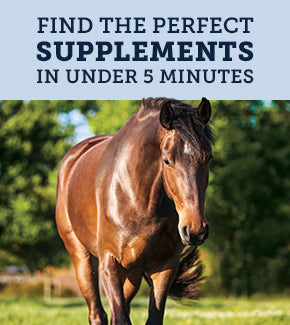Laminitis, commonly known as founder, is a painful condition that affects a horse’s hooves, causing inflammation and potential detachment of the soft tissue (laminae) from the hoof wall. In severe cases, this can lead to rotation or sinking of the coffin bone, resulting in chronic pain and mobility issues.
Understanding the causes and providing proper support—both through diet and natural supplementation—can make a significant difference in managing and preventing laminitis.
Signs and Symptoms of Laminitis
Early detection is key to preventing long-term damage. Horses experiencing laminitis may show signs such as:
✔Sore front feet, particularly when turning or walking on hard ground
✔Warm hooves or an increased digital pulse in the lower leg
✔Reluctance to move or a rocked-back stance to relieve pressure
✔Visible discomfort, especially when shifting weight between hooves
✔Hoof wall separation in severe cases
Common Causes of Laminitis
Many factors can trigger laminitis, so identifying the root cause is crucial for effective management. Some of the most common causes include:
Metabolic and Hormonal Conditions
Horses with insulin resistance (IR), Equine Metabolic Syndrome (EMS), or Cushing’s disease are at higher risk. These horses often show signs such as:
- A cresty neck
- Fatty deposits over the tailhead
- Easy weight gain or weight loss fluctuations
Thyroid Imbalance
A compromised thyroid can contribute to laminitis, particularly in overweight or underweight horses. If you notice fatty pockets, excessive weight changes, or a cresty neck, thyroid function may be a concern.
Recommended Support: Instead of laminitis-specific support, these horses may benefit from a thyroid-supporting herbal blend.
Dietary Imbalances & Overeating
- Horses consuming too much sugar and starch—whether from grain, rich pasture, or alfalfa hay—can develop laminitis due to metabolic overload.
- Sudden dietary changes, such as escaping into a grain bin or consuming lush spring grass, can trigger an acute laminitis episode.
- Overworked kidneys struggle to filter excess carbohydrates and toxins, contributing to inflammation.
Recommended Support: For horses that have experienced dietary-related laminitis, supporting the kidneys with detoxifying herbs is essential for long-term recovery.
Toxin Exposure & Other Causes
- Certain medications, illnesses, or infections can trigger laminitis.
- Hoof trauma or mechanical stress (such as excessive weight-bearing due to injury in another limb) can also contribute to founder.
How to Feed a Horse Prone to Laminitis
A balanced diet is the foundation of laminitis prevention and recovery.
✔ Choose Low-Sugar, High-Fiber Forage: Grass hays like Timothy, Orchard, or Bermuda are best. Test hay for sugar levels and aim for NSC (Non-Structural Carbohydrates) below 10-12%.
✔ Avoid High-Starch Feeds: Skip molasses, grain, and sweet feeds. Opt for low-starch alternatives like Timothy hay pellets or beet pulp (soaked and rinsed).
✔ Limit Grazing on Lush Pasture: Use a grazing muzzle or restrict turnout to times when sugar content is lower (early morning or late evening).
Natural Support for Horses with Laminitis
Supporting the soft tissue of the hoof, promoting circulation, and reducing inflammation can help horses recover and maintain soundness.
Laminae Support: A Natural Solution for Hoof Health
This powerful herbal blend contains key ingredients designed to support hoof integrity, circulation, and inflammation management:
🌿 Boneset – Natural pain relief and immune support. Contains calcium, magnesium, potassium, and B-complex vitamins.
🌿 Butcher’s Broom – Supports circulation in the lower limbs. Rich in iron, manganese, niacin, and vitamins A, B, and C.
🌿 Devil’s Claw – Assists in clearing impurities from the body. Supports kidney function and contains calcium, phosphorus, selenium, and vitamin C.
🌿 Garlic – Boosts immune function and fights bacterial infections. Provides iron, manganese, potassium, and sulfur.
🌿 Hawthorn – Helps regulate the heart and dilates blood vessels to improve circulation. Contains choline, inositol, and vitamins A, B, and C.
🌿 Juniper – A natural diuretic that supports kidney detoxification. Rich in copper, sulfur, and vitamin C.
🌿 Kelp – Contains fucoidan, a complex carbohydrate that helps reduce inflammation. High in iodine, iron, and vitamin A.
🌿 Marshmallow – Soothes and heals irritated tissues. Contains calcium, sodium, and B-complex vitamins.
🌿 Oregon Grape – Supports liver function and detoxification. Provides manganese, zinc, and vitamin C.
🌿 Slippery Elm – A natural protector and healer for tissues, particularly the GI tract. Contains iodine, phosphorus, selenium, and vitamins A and K.
🌿 Uva Ursi – A natural diuretic that supports kidney health. Rich in iron, manganese, and vitamin A.
🌿 White Willow Bark – A natural pain reliever with anti-inflammatory properties. Contains calcium, magnesium, zinc, and vitamins A, B, and C.
🌿 Yucca – Helps manage inflammation and pain. Contains calcium, iron, phosphorus, and vitamins A, B, and C.
Managing and Preventing Laminitis Long-Term
Taking a proactive approach to laminitis can help prevent flare-ups and improve hoof health:
✔ Routine Farrier Care: Regular trims help maintain proper hoof balance.
✔ Dietary Management: Monitor sugar intake and maintain an appropriate body condition.
✔ Exercise & Circulation Support: Movement promotes blood flow to the hooves—gentle exercise is beneficial for recovery.
✔ Herbal Support: Targeted herbal blends like Laminae Support provide long-term hoof and metabolic health benefits.
By identifying the root cause, making dietary adjustments, and using natural herbal support, you can help keep your horse comfortable, sound, and thriving for years to come.







